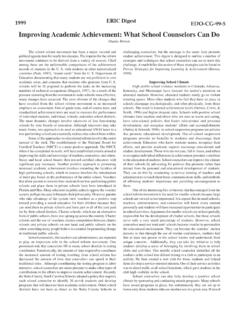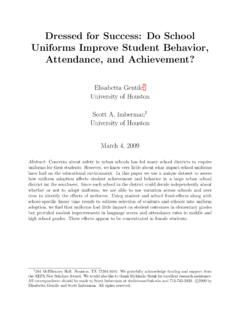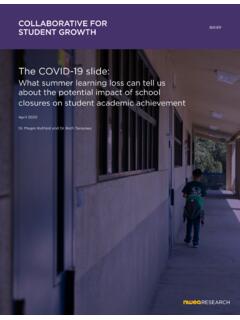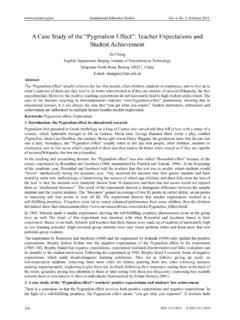Transcription of The Effect of Emotional Intelligence on Student Success
1 25 Journal of Adult Education Volume 44, Number 1 2015 The Effect of Emotional Intelligence on Student Success Krysta Chapin Abstract Emotional Intelligence (EI) is the ability to recognize, assess, and control one's emotions, as well as the emotions of others, and even groups. It also allows people to handle added pressures, as they often experience in higher education. Occasionally clinicians report a small number of senior veterinary medicine students lack the ability to assess human clients and their animal patients. The purpose of this review was to examine EI as a possible tool to predict, identify, and improve Student performance and Student Success in the clinical environment. Research was conducted that supported the ability of EI as a tool to predict Student Success in relations to clients and patients. EI was shown to generally improve for students and staff when trainings and workshops were implemented.
2 EI education may benefit most individuals, however, specific research for EI improvement concerning medical students identified as lacking compassion was deficient. Clinicians that work with students on the veterinary hospital floor are reporting a number of senior students that lack a certain awareness for their patients. These students are at a critical point in their academic career. They will be allowed to walk during the graduation ceremony, but they will not actually be graduating. They will have to come back and repeat the rotations that they have not passed. This is their last opportunity; if they do not improve their abilities they will not earn a degree, and will not have the option of repeating the curriculum. Certainly after four years in a professional program instructors do not want their students to fail. Shapiro (2011) notes that medical doctors tend to mistrust emotions and intellectualize them in order to remain objective.
3 Thus some turn Emotional constructs like suffering, compassion, and sensitivity into a set of cognitive and behavioral skills, which can help them to remain distant. If there is a significant amount of distance in a Student , to the level that a Student could potentially do more harm than good for a patient, perhaps medicine is the wrong profession. However, would it not be better if that Student could be identified at an earlier point in their education, giving them more time to address the problem, and increasing the chance of that Student 's Success ? By studying Emotional Intelligence and its relationship to Student performance I intend to determine its ability as an accurate identifier, predictor, and tool to improve Student Success in the clinical environment. students are in this program for four years and the hope would be to identify poor performers early.
4 If Student Success can be better assessed in the first or second year of their academic career it will provide an opportunity for early intervention for the students who need it. The 26 program would be able to support the students who need it with resources such as mentors and a long term plan to build their Emotional Intelligence , helping to avoid potentially graduating a Student that does not connect to their patients. Learning from Human Medicine One or more veterinary programs utilize curriculum from, and are looking to collaborate further with local human medical schools. This partnership is a logic option for many reasons. Both veterinary medical students and human medical students have similar academic demands, including stress, content and workload. Furthermore, veterinary students have the necessity of discussing euthanasia with their clients, which may add to their stress level.
5 They also have to be familiar with the complexities of multiple animals. For the reasons that the veterinary medical Student and human medical Student experiences are so similar, with the veterinary experience potentially being more stressful, it is fair to look at the results of human medicine Student studies and apply them to the veterinary medicine Student (Adams & Kurtz, 2006; Hafen, Reisbig, White, & Rush, 2006). Therefore, human medical and veterinary medical studies were accessed together. The EBSCO and PsycINFO databases were searched for primary sources such as peer reviewed journal articles. Search strategies were based on a combination of synonyms of relevant components; Emotional Intelligence , Student Success , Student behavior, Student stress, Emotional Intelligence predictor, Emotional Intelligence assessment, medicine, veterinary, etc.
6 All sources and references were critically evaluated. Ending with EI s usage in the medical field and veterinary medicine specifically. Findings Emotional Intelligence (EI) is the ability to recognize, assess, and control one's emotions, as well as the emotions of others, and even groups. Possessing Emotional Intelligence gives students the ability to make common-sense decisions, take intelligent calculated risks, and navigate difficult social situations. It also allows students to handle the added pressures of setting and achieving goals in an academic setting. The pressures that come with attaining high academic requirements can become overwhelming for many, and students should be capable of managing and controlling the pressure that they feel (Saibani, Sabtu, Muhamad, Wahab, Sahari, & Deros, 2012). Two Categories of Conceptualizations There are multiple conceptualizations of EI, however, most models of EI can be divided into two broad categories: ability models, and trait and mixed (dispositional) models (Spielberger, 2004).
7 Ability models are expansions of information-processing theories of Intelligence and conceptualize EI specifically as an Intelligence (Salovey, & Mayer, 1990). They view EI as a set of cognitive abilities that relate to the perceiving, understanding, using and managing Emotional information (Goldenberg, Matheson, & Mantler, 2006) and as a further dimension of intellectual ability not measured by established conceptualizations of Intelligence . Trait models ( Petrides, Pita, & Kokkinaki, 2007) and mixed (dispositional) models ( Goleman, 1998; Bar-On, 1997) view EI as a set of interrelated competencies, skills, abilities, personal qualities, and personality traits. There are commonalities amid the main components of the two types. Both agree that EI is multidimensional, a construct with both cognitive and Emotional elements, consisting of the ability to identify, confront, and apply Emotional information to everyday decision making and actions.
8 They both regard a person with higher levels of EI as being able to link emotions and reasoning; to use emotions to facilitate reasoning, and to reason wisely about feelings. Similarly, all methods use a standardized self-assessment questionnaire to measure EI. The consistency, validity and cross-cultural application of the assessments differ along with the amount of common characteristics between individual assessment questions. It is also essential 27 to note that an individual s EI is distinct from an inclination to experience specific emotions (George, 1996 & 2000). Furthermore an individual s EI does not relate to how powerfully he or she experiences emotions, it represents the amount to which an individual s cognitive capacities are informed by their emotions, and the level at which that person cognitively manages those emotions. To the degree with which an aspect of personality can be falsified, evidence from simulations has shown that fakers accumulate excessively at the top end of personality score distributions and that validity in this top region is most at risk (Mueller-Hanson, Heggestad, & Thornton, 2003).
9 Along with that Tett and Christiensen (2007) note that they expect candidates to typically fake upward, to the degree of half a standard deviation, which translates into roughly 10% of desirability variance being attributable to candidate faking. EI and students Previous studies have revealed that trait EI, which has stronger relationships with personality, can be a predictor of effectiveness and explain variances in Grade Point Average (GPA). One academic study has shown that students who obtained high marks at the end of their first year scored significantly higher on EI than a comparison group who obtained poor grades and were at risk of dropping out (Parker, Summerfeldt, Hogan, & Majeski, 2004). An additional study (Parker, Austin, Hogan, Wood, & Bond, 2005) has shown that alexithymia, the inability to identify and describe emotions in the self, is related to low EI, and is a significant predictor of low Student Success .
10 Some researchers have warned that EI as a tool should be used cautiously in education, particularly in medicine fields, specifically as a predictor of future clinical and interpersonal Success (Lewis, Rees, Hudson, & Bleakley, 2005). Cherry, Fletcher, O'Sullivan, and Dornan (2014) go on to note that at this point EI is still best for those looking at research and development, and not an exclusionary tool for educators and admissions. However, it is reasonable to expect curricular changes that can be informed by EI in order to facilitate Student development. Carrothers, Gregory and Gallagher (2000) looked at the admission process for a six year BS/MD program at Northeastern Ohio University College of Medicine where an EI instrument was developed for the basis of admissions. In correlations with GPA and other factual knowledge indicators the EI instrument was weakly correlated, however it was strongly correlated as a measure of desirable personal and interpersonal skills as to how well a Student was able to perform the social role of being a physician.


















